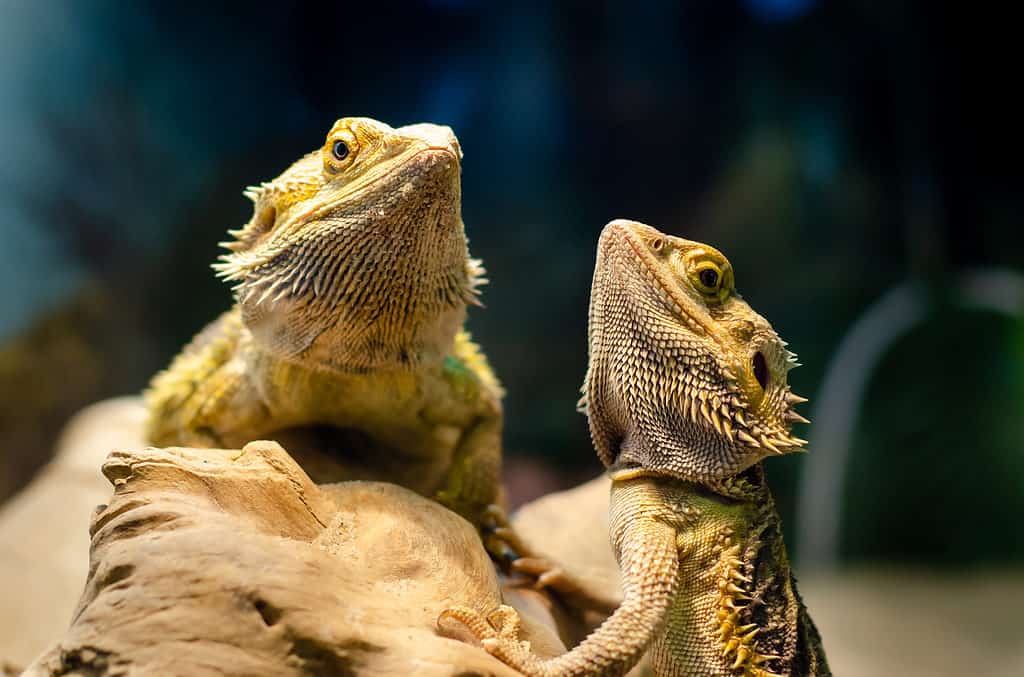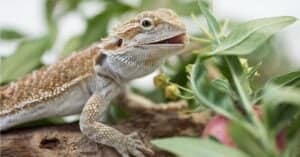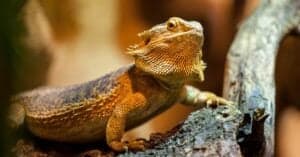Also called tail necrosis, tail rot is relatively common in bearded dragons. They’re active lizards that take falls, and they’re territorial and may fight with other beardies.
Tail rot can often cause secondary infections that can kill your bearded dragon. So, understanding what to look for, and what to do if it happens can save your beardie’s life.
In bearded dragons, tail rot begins when blood stops circulating and tissues become infected and start dying. However, there’s more to tail rot than meets the eye – so let’s look at tail rot’s symptoms, causes, treatment, and prevention.
Bearded Dragon Tail Rot Symptoms
There are a few clues that will tell you whether you’re looking at a little stuck shed or actual tail rot. It often starts right at the end of their tail and then spreads, killing more tissue along the way.
Color Change
An early symptom of tail rot is a change in skin color, especially underneath the tail. Their skin begins to darken and you can’t get it clean. Skin color changes are hard to see in darker bearded dragons, so vigilance is key.
Dehydration
Their tail may feel dryer than the rest of their body, with flakey skin in the area. If a 20-minute soak in warm water doesn’t improve things, it may be time to call your veterinarian.
Skin Texture Changes
This sort of goes along with the general skin flakiness that dehydration causes, but it goes further. The skin doesn’t look or feel normal anymore. If it’s gotten to this point, your beardie needs to see the vet.
Behavioral Changes
These may be more subtle than the obvious physical symptoms but are no less important. Here are a few things to look out for:
- Your bearded dragon may become agitated and seem irritable or even aggressive.
- It may lose its appetite.
- A beardie may become withdrawn and hide more than usual.
- If you touch the tail, or your bearded dragon’s tail touches something, it reacts as though it hurts.
How Dangerous is Tail Rot (Tail Necrosis) in Bearded Dragons?
Extremely.
Although it isn’t contagious, tail rot can cause secondary internal infections that spread throughout your bearded dragon’s body. These infections are usually bacterial and can move quickly once they have a foothold.
Untreated tail rot can easily be fatal or require amputation to stop the infection’s spread.
Causes of Tail Rot in Bearded Dragons
Tail rot can happen to any reptile, but it has a few general causes – and some can be prevented!
Fights, Injury, and Other Trauma
Some sort of trauma is a common cause of tail rot among bearded dragons. These active lizards love climbing and exploring, so falls and other accidents related to their activity aren’t uncommon. Another cause of trauma is a fight with another beardie. This species is highly territorial and placing two beardies in one enclosure is a recipe for disaster.
Poor Diet
Captive bearded dragons are more susceptible to poor diet than wild beardies, mostly because the wild ones can take off and hunt down something to eat. However, maintaining a proper diet for your beardie will prevent most health problems.
Consistent Incomplete Shed Cycles
Incomplete sheds are indicative of poor habitat maintenance, but they can cause numerous problems. While one incomplete shed may not be a problem by itself, several incomplete sheds in a row can build up at the tail tip and cut off circulation, causing tail rot.
Poor Habitat Maintenance
Keeping your bearded dragon’s enclosure clean, with appropriate lighting, heating, and humidity isn’t too hard. However, it is vital. Because beardies are classified as desert reptiles, they require a good UVA/UVB light source, but fortunately not as much humidity.
Embolisms
Commonly known as blood clots, embolisms can travel through the circulatory system and lodge themselves in smaller blood vessels. In beardies, that’s often the tip of the tail, but can also be in the toes. Left untreated, they cut off circulation to those areas and often cause bigger problems.
Bearded Dragon Tail Rot Treatment
For tail rot, the treatment options are limited. If you catch it extremely early and it has a simple cause, like layers of stuck sheds, sometimes a soak can release the shed and the lizard can heal. Otherwise, the best option is to consult a reptile veterinarian when you suspect tail rot.
When tail rot gets established in a bearded dragon, it won’t stop. Sometimes, the tail can slough off, but tail rot often comes with or causes secondary infections.
Surgical amputation by a veterinarian, followed by painkillers and antibiotics is often the best cure for advanced tail rot. Given that fact, the sooner it’s treated, the better!

Keeping two beardies in one enclosure can cause fights because they are territorial.
©Lutsenko_Oleksandr/Shutterstock.com
Prevention
“An ounce of prevention is worth a pound of cure.”
If you’ve kept reptiles or any animals as pets, you know that keeping them healthy often means spending more time on prevention. It’s cheaper in the long run, and you have happier, healthier animals as a result.
Preventing tail rot involves a few things:
- Keep their habitat clean.
- Do not leave crickets in their enclosure.
- Take time to secure any climbing surfaces.
- Providing them with enough UVA/UVB light – up to 12 hours per day.
- Don’t cohabitate bearded dragons – one per enclosure is best.
The photo featured at the top of this post is © Claudia Nass/ via Getty Images
Thank you for reading! Have some feedback for us? Contact the AZ Animals editorial team.






